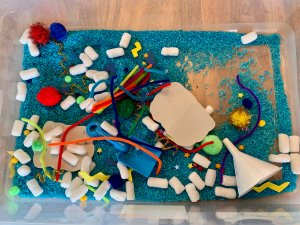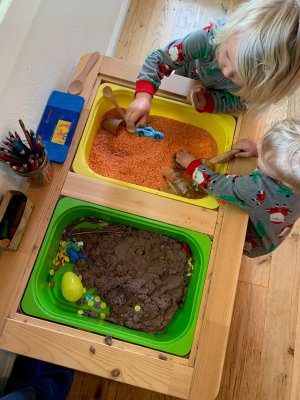DIY Ways to Meet a Child’s Sensory Needs at Home
Occupational therapists and trauma-informed teachers weigh in on how to create sensory tools and spaces with what you have at home.
Your content has been saved!
Go to My Saved Content.The coronavirus pandemic has upended all students’ day-to-day routines, but has created particular disruption for students with special needs, sensory processing disorders, and kids who have experienced trauma who rely on the structure of school to stay grounded. Creating an at-home sensory space and sensory tools that resemble the supports students received in school can help kids during this transition, easing them out of a meltdown or giving them a much-needed break before one starts.
We asked trauma-informed and special education teachers, occupational therapists, and other service providers for their advice on creating at-home sensory spaces and activities, making sensory tools from common household items, and the best practices for meeting kids’ sensory needs. We share their recommendations below.
Dedicate Space at Home
While some schools have entire rooms dedicated to sensory activities for students, most families don’t have a lot of extra space on hand. Occupational therapists emphasize that families should not stress about the size of the space—even a corner of a room with a box of sensory items will work. The important part is making sure the space—and any tools—are individualized to each child.
Be Mindful of Distractions: When determining a space, it’s important to be mindful of the surroundings, says Krista Stephens, an occupational therapist at an elementary school in South Carolina. Clutter and patterns or decorations on walls can be distracting, particularly for a child with sensory processing difficulties. Children can also easily be affected by light and noise, so caregivers should make sure the space is free of things like a TV or harsh lighting.
Make It Theirs: Household objects can also be used to make spaces more secluded, Stephens adds. Build a homemade tent with two pieces of furniture and a blanket, for example, or cut up a cardboard box to make a “desk shield” to put around a child’s work area. You can even create an under-the-table hammock by tying a sheet’s diagonal corners at the top of a dining room table for a private nook.

Add Comfort and Personal Touches: Adding inexpensive throw rugs, blankets, yoga mats, lounge pillows, and floor pillows can help designate and personalize a corner or space of a room, while bean bag and portable camp chairs can let kids move their seating based on their mood.
Create Homemade Sensory Tools
Sensory tools—tactile objects that help release or redirect energy—are an essential part of meeting a child’s sensory needs and helping them calm down and regain focus. Parents and caregivers don’t need to spend money on tools for their home, according to special education teachers and therapists from Meriden Public Schools in Connecticut—a district known for their special education services—that shared ways to make them out of household objects.

Set Up a Sensory Bin: Sensory bins, or any container filled with items that stimulate one or more of the five senses, offer a relaxing, low-demand activity for children, and can be made by filling a container with items like dry beans, rice, or pasta, and cotton balls, for example. Add tools like measuring cups, sifters, and shovels to encourage kids to explore. For an added element of fun, you can make colored rice with your kid using a bag of store-bought rice and food coloring.
Make Slime: There are a number of ways to make “slime,” a gooey substance that kids with sensory processing disorders (and really any child) like to play with. One recipe: put an egg white into a bowl, stir it, and mix it with a little dish soap, then refrigerate it for 10 hours.

Build a Sensory Bottle: Fill a water bottle stripped of labels (Voss glass bottles works best) with small items like rice, beans, seeds, sprinkles, sand, or rocks to make different sounds. Another kind can be made using materials like beads, glitter, and marbles—then add water, a few glycerin drops, and put super glue on the rim to seal the cap on. These bottles help kids calm down by focusing on the movement inside the bottles.
Support Fine Motor Skills With Generic Products: Items you already have in your home can also easily be repurposed as sensory tools. Spray shaving cream on the kitchen table and let your kids spread it around, draw images, or write words and numbers to release energy while boosting fine motor skills. You can also let your kids rip, fold, and crinkle different types of paper such as wrapping, tissue, and magazine paper.
Set Up Sensory Activities
When your child gets overwhelmed, have them take a break with a sensory activity depending on what they need—to release energy, calm down, or be alone.
Create a Sensory Path: Sensory paths, or a path made with common items like cut-out arrows, pillows, and furniture, can prompt your kid to walk, bend, and hop, which will help to regulate their bodies and transition them to the next activity. Go through the obstacle course with your child beforehand, so they’ll know what to do when.
Get Physical: Simple activities like bouncing on an exercise ball or doing bear crawls and crab walks meet the need for releasing energy, says Caley Kukla, a child development and behavior specialist based in Florida. Monica Keyser, a school district occupational therapist in California, also recommends “heavy work,” or activities that involve using a child’s muscles like pushing furniture into new arrangements or pulling a laundry basket filled with heavy items down a hallway.
Add Pressure: Some children benefit from feeling pressure on their body, which helps activate their parasympathetic response, lowering the heart rate and reducing stress. Other than a simple hug or squeeze, children find “burrito rolls” relaxing, aptly named for looking like a burrito once rolled up inside a blanket or sheet, says Hanan Huneidi, a teacher who works with students not well served by mainstream schooling. You can also have a child sit with a set of heavy books in their lap or make a weighted lap pad by filling a large sock with rice.
Inhale, Exhale: Conducting breathing exercises and simple movements in a child’s sensory space is an easy way to release stress from the body and calm the mind, says educators at Meriden Public Schools. Your child can practice mindfulness activities like deep breathing and tapping, and even making silly sounds which can be especially helpful for kids who are hypo-sensitive or under-reactive to their environment. You can also have your kid breathe in and out guided by an expanding and contracting rainbow pinwheel in this video.
Provide Soothing Stimuli: Don’t forget that simple things like giving a child a warm bath or drinking a cup of hot tea can provide the soothing effect many children need to calm down, say educators. Brushing a child’s skin lightly with a soft-bristled brush or passing ribbon over their arm, leg, or back can achieve a similar effect, adds Sarah Kesty, a middle school special education teacher.
Remember Best Practices
Parents and caregivers also need to provide guidance and structure to help children understand when and how to use sensory tools/spaces. For starters, they should be mindful of their child’s triggers and unique sensory needs—whether they need less or more stimulation, for example.

Model Behavior: Children look to adults for how to model their own behavior, says Lori Desautels, a trauma expert, so it is critical for adults to make sure they exhibit calm behavior—even if they don’t feel that way—when dealing with a child who is frustrated and in need of soothing. Adults should also model how to request and use sensory areas/tools so a child understands what to do before they are in the midst of a meltdown.
Notice the Signs: A child may get stressed out or even meltdown when asked to do an activity they don’t want to do, or as they transition to something new. Physical behaviors like rocking, fidgeting, or being clingy might indicate a child is subconsciously trying to calm themself down, says Stephens. Adults should watch for these signs, then encourage their children to use their sensory supports before things get out of hand.
Provide Structure: Timers can help give children structure and motivation to focus, says Huneidi. If a child is struggling to pay attention, suggest blocks of time or work (like 15-20 minutes) followed by a sensory activity or use of a sensory tool. It can also be helpful to identify keywords and cues your child can use if they feel overwhelmed.
Offer Breaks: Try to offer sensory breaks before a child is having a meltdown, emphasizes Desautels; that way, sensory breaks are not thought of by the child as a punitive measure. By giving a child a sensory tool in advance of the meltdown, the child is more likely to regain focus and regulation more quickly on their own.
